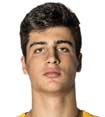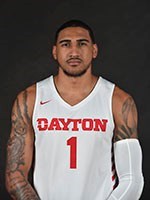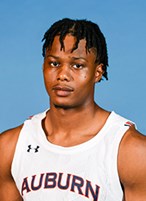By Harper Mayfield | Sports Writer
This NBA season was unlike any before it and the upcoming offseason looks to be following suit.
The NBA Draft, slated for Nov. 18, will occur only 38 days after the conclusion of the NBA Finals. This offseason will be the shortest in recent history, but that hasn’t kept intrigue from developing over the next big class that will decide the league’s future.
Many view this draft as the weakest in years, but the same was said of the 2013 class, which has since produced stars like Giannis Antetokounmpo, Victor Oladipo, Rudy Gobert and CJ McCollum. Despite the alleged absence of future stars, much of the 2021 season hinges on what happens in this year’s draft. Nothing is more important to this draft than the players available to be selected, so let’s get to know this year’s best and brightest.

Anthony Edwards, SG, Georgia: Edwards jumps off the page physically, standing 6-foot-5 and tipping the scales at 225 pounds. Those physical gifts were put to use by the Bulldogs, but Edwards struggled mightily with efficiency as the No. 1 option. Shooting splits of 40.2/29.4/77.2 don’t bode well for Edwards’ prospects as the leading scorer for an NBA team. Despite his struggles from the field, Edwards did put up solid numbers during his time in Athens. Edwards led Georgia in scoring at 19.1 points per game and also posted averages of 5.2 rebounds per game and 2.8 assists per game.
Edwards is likely to go at or near the top of this year’s draft, and could fit especially well with the Minnesota Timberwolves or Charlotte Hornets, both of whom could use an extra scoring punch to make the leap to the playoffs. Teams that should remain wary of selecting Edwards include the Cleveland Cavaliers, Chicago Bulls and Atlanta Hawks. Edwards doesn’t stand out as a defender and all of those teams aren’t in the market for another offensive-minded guard.
Player comparison: Muscular Monta Ellis
James Wiseman, C, Memphis: Wiseman was the presumed No. 1 overall selection coming into the year and has remained near the top of draft boards around the league. During his time in Tennessee, Wiseman averaged 19.7 points, 10.7 rebounds, and three blocks. Convincing as those stats may be, they come in a small sample size, as Wiseman left Memphis to prepare for the draft amid a pay-for-play scandal.
Whether or not the Tigers paid Wiseman, he’s still an elite prospect. Wiseman projects as an athletic rim runner and high-level shot blocker in the NBA. He showed flashes of an outside jumper in high school but failed to hit a three while at Memphis. Wiseman reportedly has no interest in splitting time with All-Star big man Karl-Anthony Towns in Minnesota, but he could be very effective with teams like the Hornets, who are said to be very interested in Wiseman’s skill set.
Other fits for Wiseman include the Golden State Warriors and Washington Wizards, should Wiseman fall far enough for Washington to select him. Teams that should avoid Wiseman are the Bulls, Hawks and Detroit Pistons.
Player comparison: Hassan Whiteside
LaMelo Ball, PG, USA: LaMelo Ball has already been in the public eye for years, gaining fame as the younger brother of New Orleans Pelicans guard Lonzo Ball. While Lonzo attended UCLA for a year, LaMelo opted for a different route, playing a season with the Illawarra Hawks of Australia’s National Basketball League. Ball’s numbers in the NBL were solid, but like Edwards, there are efficiency concerns. Ball shot 37.5/25/72.3 in 12 NBL games. There’s no two ways about it, those numbers are bad. Ball has made his name with highlight reel passes and three pointers from half court, but flash only goes so far. Ball certainly has ability and his physical traits — 6 feet 7 inches, 181 pounds — indicate that he could be a matchup nightmare for opposing guards.
However, he may have trouble adjusting to the NBA. Ball’s father, LaVar Ball, was notably upset with the Los Angeles Lakers’ handling of Lonzo, and could become an issue teams are unwilling to deal with. Despite Ball’s inconsistencies, he could find a home with the Hornets, Pistons or New York Knicks. Teams that should definitely look to pass on Ball include the Timberwolves, Cavaliers, Hawks and Warriors.
Player comparison: Michael Carter-Williams

Onyeka Okongwu, C/PF, USC: Okongwu, Ball’s high school teammate, has flown somewhat under the radar in pre-draft proceedings. Somewhat undersized at 6 feet 9 inches, 245 pounds, Okongwu wasn’t the media darling that Edwards, Wiseman or Ball were. While standing three inches shorter than Wiseman, Okongwu’s numbers are remarkably similar. During his time as a Trojan, Okongwu put up averages of 16.2 points, 8.6 rebounds and 2.7 blocks per game. Okongwu’s long wingspan of just over seven feet has made him an impactful defender, and looks to allow him to be effective on that side of the court in the pros. He wasn’t asked to stretch the floor often at USC, but he shot the same percentage from three and the free throw line as Ball, who some feel will be an excellent shooter at the next level.
At worst, Okongwu will be a high-energy defensive specialist in the NBA. At best, he’s a 20, 10 and 2.5 blocks guy that makes multiple All-Defense teams. I’m higher on Okongwu than most, but I think he fits in the modern NBA very well and could be the right player for teams like the Cavaliers, Wizards or Hawks. Teams that don’t need a player like Okongwu at the moment include the Timberwolves, Knicks and Bulls.
Player comparison: Tyson Chandler

Deni Avdija, SG/SF, Israel: Coming off the success of international superstars like Antetokounmpo, Luka Doncic and Nikola Jokic, every team is looking for the next big thing from overseas. This year, it’s Avdija. Avdija most recently played for Maccabi Tel Aviv in Israel, where he averaged four points, two rebounds and 1.2 assists in 14 minutes a night. Those numbers, while not impressive, don’t tell the whole story. Avdija was a primary ball handler in Israel, a role he likely won’t be asked to fill in the NBA. Additionally, Avdija has great size for any position one to three. At 6 feet 9 inches, 215 pounds, he has an NBA ready frame. Once he’s in the league, Avdija can check a lot of boxes for a team.
A strong ball handler, Avdija can be asked to run an offense while a more traditional point guard is off the floor. Avdija can also play off the ball, with a strong back to the basket game. A truly versatile wing, Avdija fits like a glove with teams like the Warriors, Bulls or Suns. Teams that should shy away from Avdija on draft night are the Cavaliers, Hawks and Timberwolves.
Player comparison: Justise Winslow

Obi Toppin, SF/PF, Dayton: Toppin, fresh off a National Player of the Year award, is seen by many as one of the elite prospects in this draft. I, however, don’t agree. Toppin is a phenomenal run and jump athlete, but that can cause people to gloss over the holes in his game. Toppin averaged 20 points, 7.5 rebounds and 2.2 assists at Dayton this year and flew up draft boards while doing it. Over the course of the season, Toppin threw down some serious dunks that had him on SportsCenter night after night. He doesn’t do much else. He seems to be incapable of stretching the floor and isn’t great at the free throw line. Where he is great, though, is around the rim. Toppin shot 63% from the field this season and did so by creating good looks for himself in the paint. As valuable as that skillset was in the NCAA, the NBA needs forwards who can create space for the offense, and it remains to be seen if Toppin is a player that can do that.
Toppin’s athleticism doesn’t translate well to defense either, as he often looks stiff trying to cover dynamic scorers. Toppin is also 22 already, not ideal from a developmental perspective. As you can tell, I’m out on Toppin. That isn’t to say he’s a bad player, I just don’t think he’s in the same space as some of the other prospects in this draft class. Maybe I’m wrong. I’d love to be.
Player comparison: Derrick Williams

Isaac Okoro, SF, Auburn: Okoro has come out and said he believes he’s worthy of the No. 1 overall selection. That feels like a bit of a stretch. Okoro is likely the draft’s best perimeter defender but he struggles with the offensive portion of the game. An effective field goal percentage of 55.6 doesn’t scream “wing scorer extraordinaire” but that isn’t Okoro’s calling card. Okoro was a +2.5 on defense and projects as an upper-tier wing defender in the NBA. That said, lots of questions about his offensive game remain. Coaches have praised his work ethic, and maybe it pays off in the form of a refined game with the ball in his hands. If it does, Okoro could be the steal of the draft. Right now, he looks like a solid role player that can give the other team’s best scorer some trouble. Teams where Okoro fits best include the Warriors, Bulls, Hawks and Spurs. Okoro could find himself out of place with the Hornets, Pistons or Knicks.
Player comparison: Old Andre Iguodala
These players will all hope to hear their name called near the top of the draft, which will be aired on Nov. 18 at 7 p.m. eastern on ESPN.





